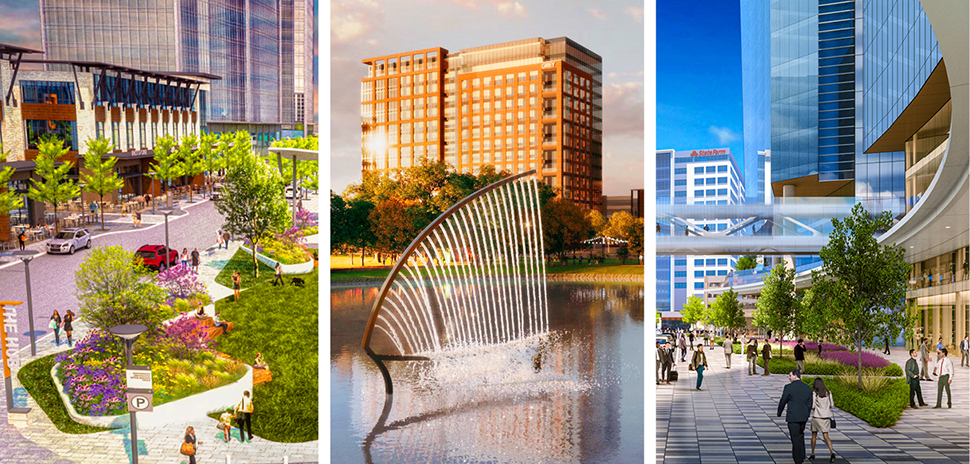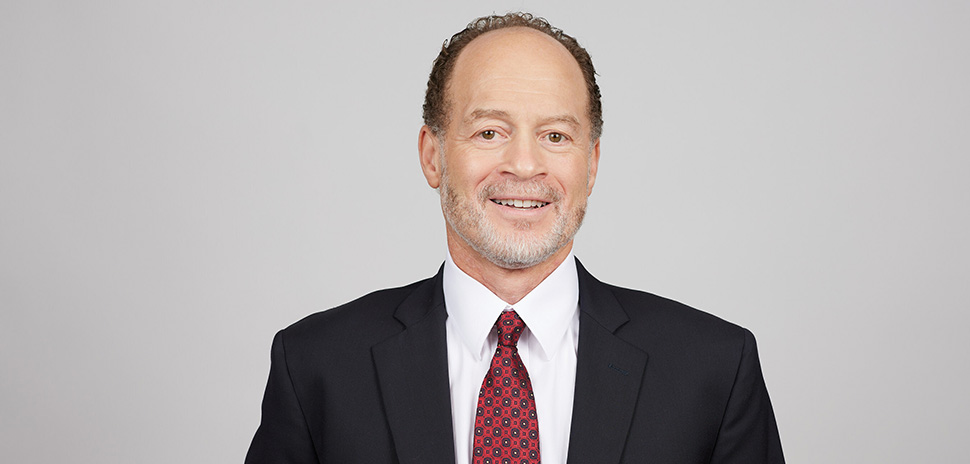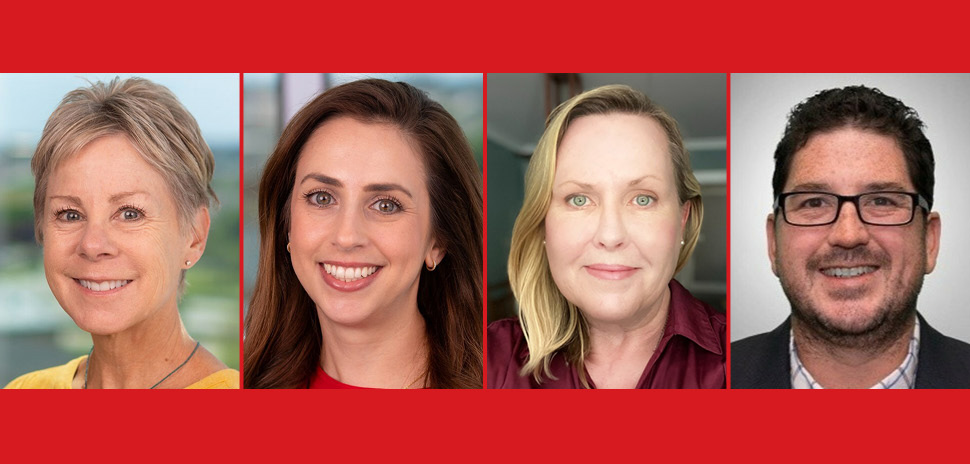Buckle up. Three top North Texas mixed-used developments—Cypress Waters, CityLine, and Frisco Station—are shifting into high gear on their way to the future. Just ask the leaders who’ve driven their evolution for years.
Lucy Billingsley, Michael Alost, and Robert Folzenlogen talked with us about what it takes to build a future-proof place for people and companies. Each aims to mark success across decades for their developments. Their projects started with a bold vision—and a great location. Here’s what happens next.
Right Place, Right Time
“We have a real opportunity to do something that’s great for the future,” says Lucy Billingsley, the co-founder of Billingsley Company and visionary developer of Cypress Waters. “This is an incredible time with the market we’re in, and we need to rise to the occasion and build quality improvements.”
It’s the opportunity to design the “community we’re going to be living in for the next 30, 40, 50 years,” she says.
It’s no secret that Dallas-Fort Worth commercial real estate is now a top draw for foreign investors. Dallas rated first among large U.S. metros for investment in the first half of 2021. And pandemic-fueled moves by people and companies mean a greater need for all kinds of development, as the region continues to lead the pack in population growth.
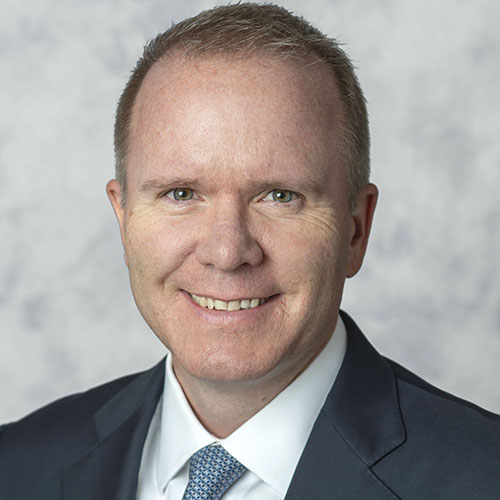
Robert Folzenlogen
Robert Folzenlogen, senior vice president of strategic development at Hillwood, runs point on Frisco Station. “What we have here are very business-friendly, development-friendly cultures and land so we can grow the market in density,” he says.
Folzenlogen believes “we’re well-positioned as a region to come out of the COVID world and continue to grow.”
Michael Alost—senior vice president of development for KDC and a key leader for CityLine—couldn’t agree more. “How fortunate we are,” he says, “to be in this place at this time.”
Alost says he knows why businesses are packing up shop from places like San Francisco and Manhattan to move to DFW.
Advantages Over Other Metros
“Three things make us successful and give us an advantage over other metro areas,” he says. At the top of the list is the way local governments partner with businesses. The region’s economic development teams put great emphasis on the benefits their citizens gain when businesses relocate to their cities, bringing more jobs. The tax base gets bigger, providing more funds for schools, parks, and improved services.
“Speed to market is made possible by government partnerships.”
Then there are the entitlements and the timely zoning approvals, which fuel a little engine called “speed to market,” Alost says. A major office expansion or redesign that could take nearly a decade in some markets can happen here in a fraction of that time.
“A company today has to innovate rapidly, adjust, and evolve quickly,” he says. “They don’t want to wait 7 to 10 years to see if they can modify their workspace.”
Instead, they come to Texas and find city governments that want to work with them so both the company and the city benefit from growing businesses contributing to the economy.
“Speed to market is made possible by government partnerships,” he says.
North Texas’ “Transactional Efficiency”
Alost’s colleague Walt Mountford, KDC’s executive vice president of development, calls it “transactional efficiency.” Many North Texas governments are proactive in starting on infrastructure before deals are signed.
Finally, there are the hard-working people who live here. Whether they were born here or not, they tend to adopt the confident optimism that Texans are known for.
Alost says he’s had a lot of friends who moved to North Texas from other places, not sure that they would like it. There are no mountains or ocean beaches, just prairie. But what ends up winning newcomers over are the friendly folks who welcome them into their communities.
“This state and region have a rawhide, independent, welcoming, casual, smart culture. Our values and style set the tone.”
The values and ethics of Texans give them pride and a can-do attitude that are yielding benefits today by attracting great resources, Alost says.
“We’ve created this great environment, and we need to maintain it,” he adds.
The lead-up to today’s boom started well before the pandemic—and its roots are in the culture.
No one knows that better than Billingsley.
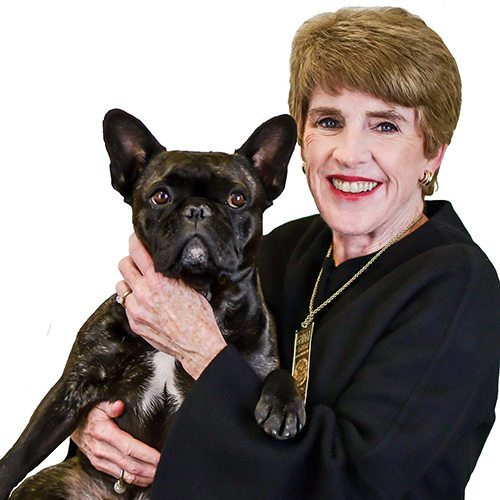
Lucy Billingsley and Shadow
“The momentum in Texas, like many things, has been a long time in coming,” she says. “This state and region have a rawhide, independent, welcoming, casual, smart culture. Our values and style set the tone. Other places have different styles and culture where for years it’s getting tougher and tougher to do business, while here it’s getting better.”
Creating Places People Want to Be
There’s more to a successful development than “location, location, location,” but it definitely starts there.
To create a place where people want to be, you need a prime spot near major thoroughfares. Then you need visionary, hyper-motivated development teams, community buy-in, heaps of patience—and key ingredients people just can’t live without.
“What we try to create are places that anyone, and all of us, consider as their own spot,” says Billingsley, the daughter of Dallas real estate titan Trammell Crow. She co-founded Billingsley Company with her husband, Henry Billingsley, in 1978.
Billingsley Company is the force behind Cypress Waters, a 1,000-acre master-planned development at Interstate 635 and Belt Line Road in the northwest corner of Dallas.

Cypress Waters
“It starts with a great location,” she says. “You’re really lucky if you have natural amenities like trees, water, and interesting topography.”
Located just minutes from Dallas-Fort Worth International Airport, Cypress Waters centers on North Lake, built in the 1970s for a nearby power plant.
After you’ve picked your spot, you turn your focus to the public realm: streets, parks, and schools, with everything integrated into nature.
Next, you plan for rich amenities to make the space a buzzing hub for workers and residents alike. Then you’re ready to start thinking about offices and residences, Billingsley says.
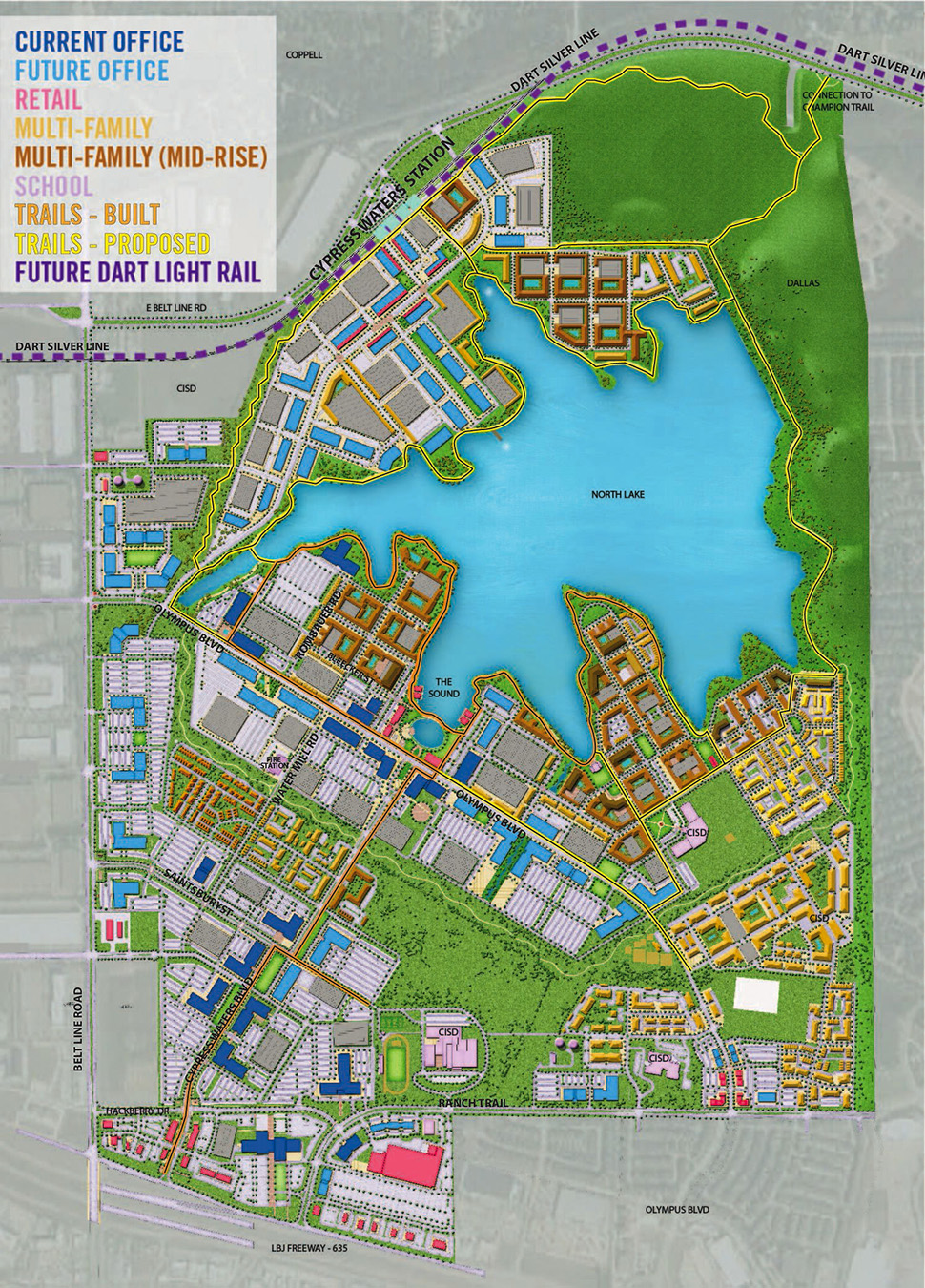
Cypress Waters’ masterplan in Sept. 2021
Overcoming Huge Hurdles
Her company began buying parcels in 2003 and broke ground in 2012. It wasn’t always smooth sailing in the early days. Billingsley had to overcome huge hurdles to make Cypress Waters a reality—from dealing with multiple jurisdictions to a lack of infrastructure to lawsuits. Although most of Cypress Waters is officially in the city of Dallas with a southern strip of land in Irving, it’s located next to the city of Coppell and inside the boundary for Coppell ISD. Both entities filed lawsuits against Billingsley Co. due to concerns about strains on resources. But the Billingsleys proved to be good partners, and Cypress Waters began generating community resources. “When we started, there was nothing in the area like what Cypress Waters has become,” she says.
“We had to respect what was there and play to the market we were in, and yet work for something much more significant.”
Billingsley has called the development a 25-year-vison.
Today, Cypress Waters has more than 3.25 million square feet of office space and three multifamily communities, with more of both under construction, plus more than a dozen spots for a meal, a drink, or a coffee.
Once completed, the development is expected to include 8 to 9 million square feet of office and retail space, 10,000 multifamily residences—comprised of distinct neighborhoods with individual personalities—along with three schools, parks, nature trails, and a town center area spread across 1,000 acres.
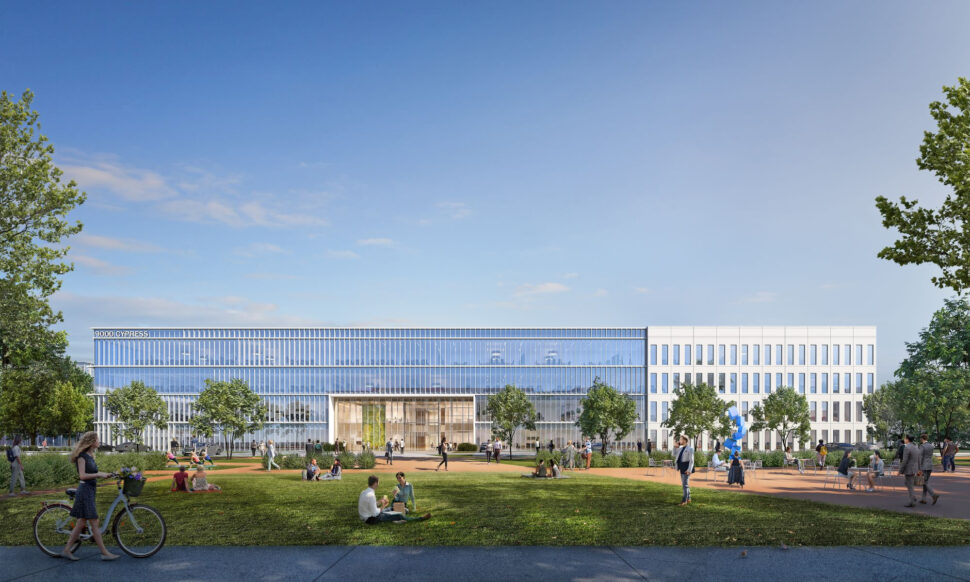
At Home, the discount big-box home furnishings store, will move its headquarters from Plano to Cypress Waters in northwest Dallas late this year.
Creating Critical Mass from the Beginning
CityLine’s Alost believes a great mixed-use development needs momentum. “You want to create a critical mass from the beginning,” he says. Then there’s the “quality of the street” and a focus on making the spaces you create “feel exciting.”
CityLine, a 204-acre mixed-use development bordered by the President George Bush Turnpike and U.S. Highway 75, broke ground in 2014.
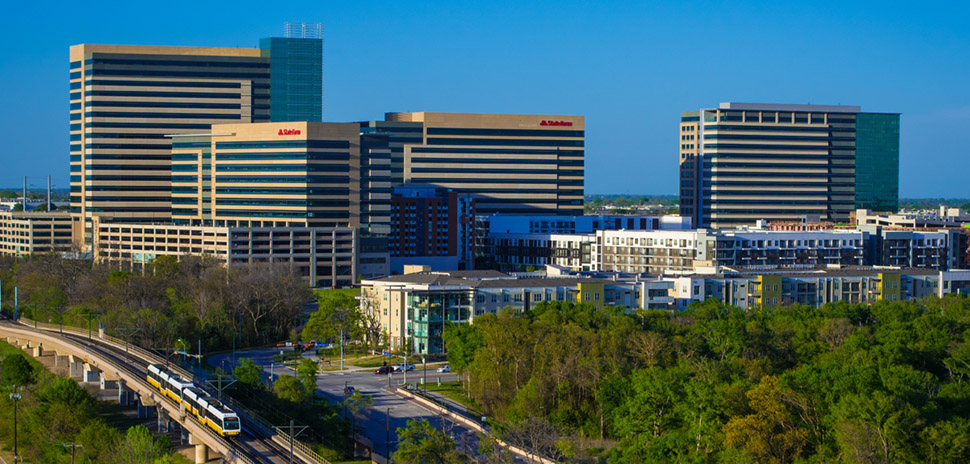
CityLine [Photo: Michael Samples]
At the time, Toby Grove, president of KDC, said, “We were seeing more interest from corporate users in transit-oriented, live-work-play developments.” Before building began at CityLine, State Farm signed on for a regional hub, which would draw 16,000 people to the site daily.
It was a critical mass that would support “the residential and the retail and provides a great environment for employees,” according to Grove.
Late the next year, State Farm’s hub opened, followed by Raytheon’s intelligence, information, and services operations. Now CityLine features 2.5 million square feet of office space, more than 200,000 square feet in restaurants, retail, and entertainment, and more than 20 acres of parks.
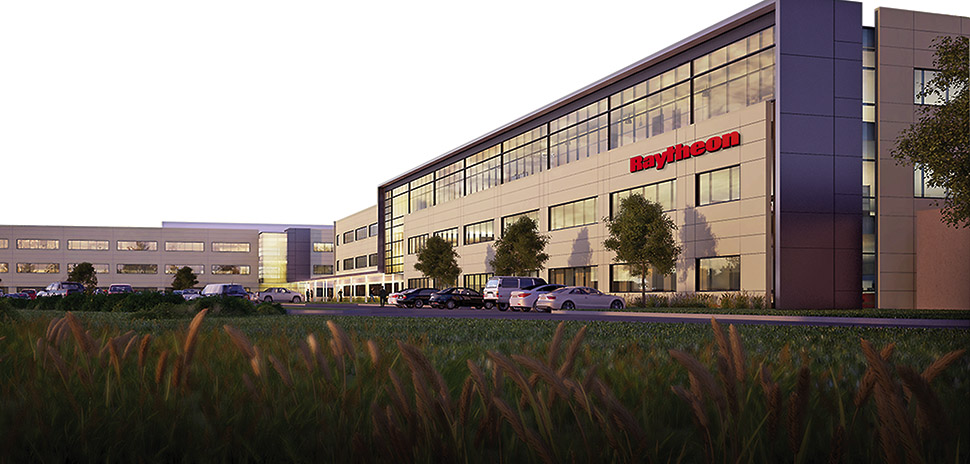
Raytheon’s new campus will be secured by a 6-foot fence and have 24-hour manned guard shacks at all three entrances. [Rendering: HKS]
They started with open fields, but Alost says that Richardson city officials were quick to put in the initial drainage and utilities and approve the zoning. By the time State Farm signed on, they had entitlements in place.
Because the city showed so much of the aforementioned “transactional efficiency,” KDC could respond quickly once the deal was in place.
After you identify the initial anchor, Alost says you’ve got to deliver on a well-rounded community.
“In every business—the hotel business, the apartment business, the restaurant business, the corporate office business—balance is critical for us,” Alost says.
If you successfully build an engaging lifestyle vision, he believes people will come. “Companies need people to innovate and grow their business,” he says. “People have to like the places they work. In our father’s or grandfather’s day, you didn’t really need to like your workplace. Today there’s an integration of work and life. That creates interesting possibilities and an improved quality of life.”
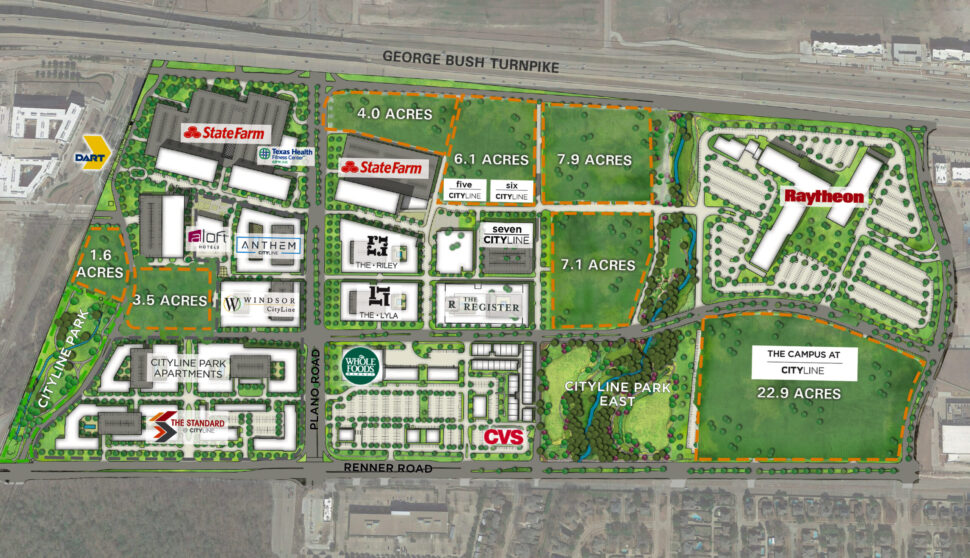
CityLIne site plan
“Today You’ve Got to Program It”
Frisco Station’s Folzenlogen agrees that critical mass is key in the success of a development—and so are events.
“You need the right mix of people living there and working there, and the amenities,” he says. “Today you’ve got to program it, have entertainment, provide open spaces and outdoor amenities, which are more popular with COVID.”
Frisco Station, a 242-acre mixed-use development along the Dallas North Tollway, was first announced in 2015 as a partnership including landowner Rudman Partnership, Hillwood as the master developer, and Kansas City-based VanTrust Real Estate to develop the office element.
Hillwood President Mike Berry said they chose the name Frisco Station because “stations are places where people go to make connections.”
In the early days of development, Hillwood President Mike Berry said they chose the name Frisco Station because “stations are places where people go to make connections.” The mixed-use project currently features more than 600,000 square feet of office space and three multifamily communities, set along a linear park and trail system. Add in three hotels and a location right next to The Star, and residents, employees, and visitors have easy access to plentiful shopping and dining.
Folzenlogen says that Frisco Station has also benefited from the innovative economic development work by Frisco city leaders. He’s amazed at how fast the Dallas North Tollway corridor in Frisco has exploded, attracting great resources like the headquarters of the PGA and the new University of North Texas at Frisco campus.
“These are big projects that benefit everyone,” he says.
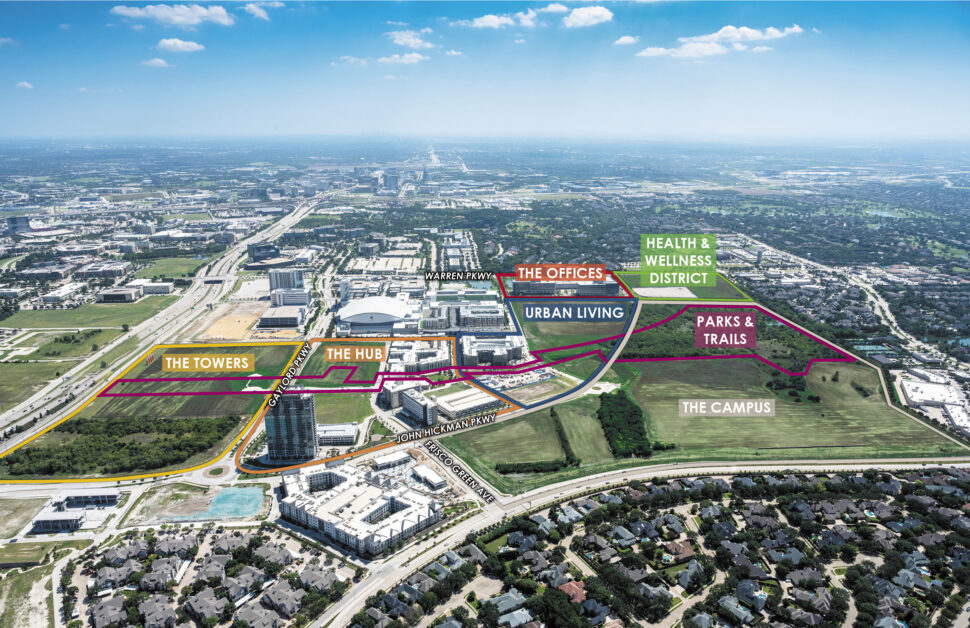
Frisco Station aerial rendering
Connectivity & Community
Connections of all kinds are high on the list of mixed-use must-haves for future-focused developments.
Frisco Station, which has a prime spot on the Dallas North Tollway, links up with the 32-acre Frisco regional trail system. It also has a stake in the future of transportation with a vertiport and a different kind of connectivity—built from the ground up—with AT&T’s 5G Evolution wireless technology.
When the deal with AT&T was announced in 2018 to make Frisco Station one of the nation’s first 5G “connected communities,” Hillwood’s Mike Berry said, “We believe we’re creating a high-tech environment, unlike anywhere else in the country, that has the potential to change the way people think about what’s possible in their day-to-day interactions with people and information.”
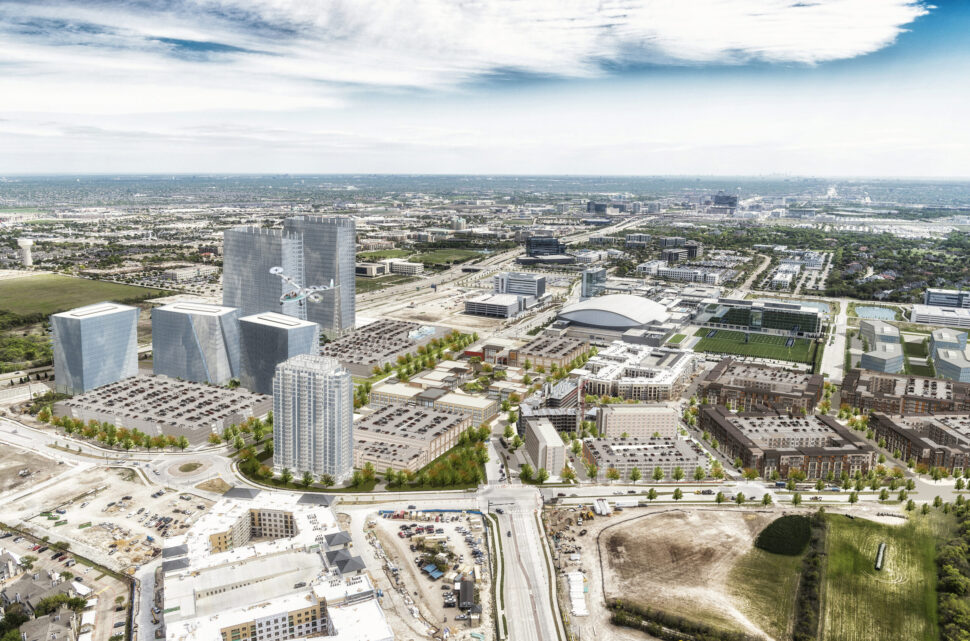
Frisco Station aerial rendering from 2018 with EVTOL
Frisco Station also boasts one of the region’s few vertiports. While the business of air taxis will need time and space to develop, another use for the vertiport is ready to go.
The vertiport will offer a drone delivery hub through a partnership with Wing, a subsidiary of Alphabet (Google’s parent company). Wing also plans to pilot deliveries from Walgreens to parts of Frisco and Little Elm.
The hub at Frisco Station will offer deliveries, provide a drone test space, and host community demos and school field trips. Wing had already partnered with Hillwood last summer in the AllianceTexas Mobility Innovation Zone to conduct drone test flights. Frisco Station has also partnered in Texas’ first pilot project to test autonomous vehicles on public roads.
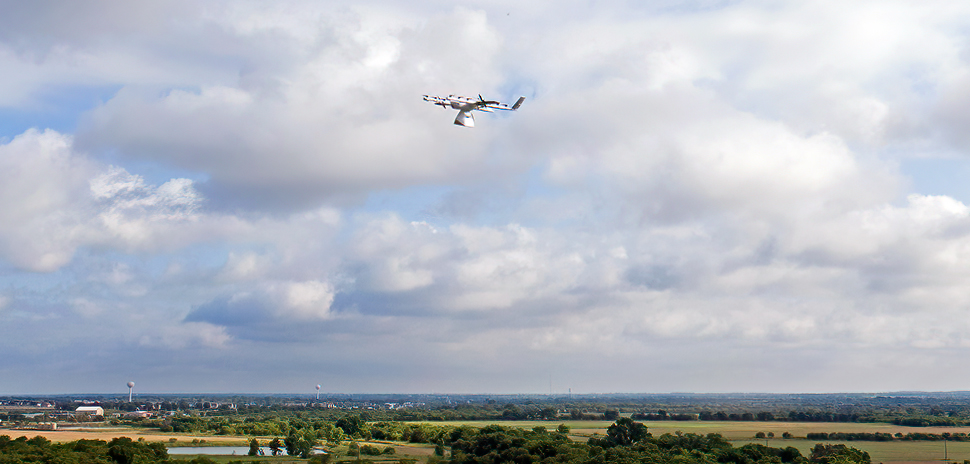
Hillwood partnered with Alphabet’s Wing to launch the first commercial drone delivery service in a major U.S. metro last fall. Wing is operating a drone delivery facility at the Frisco Station development.
The smart community also puts a premium on the social side of connection. Frisco Station hosts events within its multifamily communities, from cooking classes and yoga to happy hours and dog park get-togethers. Folzenlogen says they’re looking to add more healthy activities, like 5K runs, with the recent addition of a 35-acre Health & Wellness District. “The foundational pillars that drive our plan and program are smart, creative, and healthy,” he says. “That healthy piece has been important from Day 1—and it’s even more important post-COVID to attract talent.”
Frisco Station’s New Health & Wellness District
In October, the Frisco Station Partnership announced a deal that makes Dallas-based Cambridge Holdings the exclusive provider of health-related projects in the new Health & Wellness District in the southwest corner of the property.
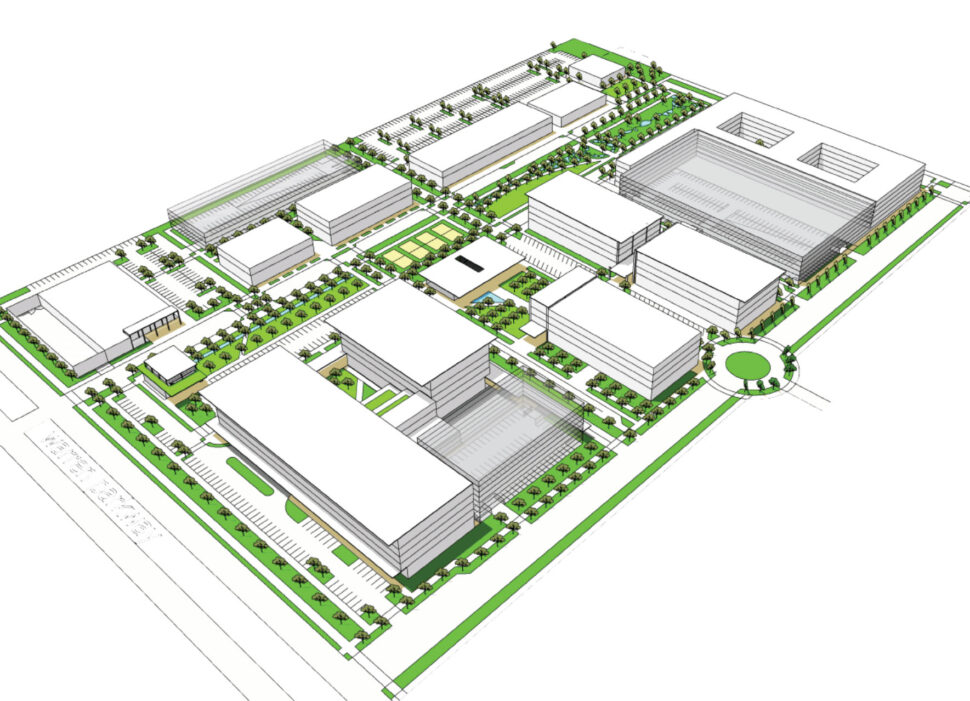
Dallas-based Cambridge Holdings will develop a variety of healthcare projects for the 35-acre Health & Wellness District in the southwest corner of the property, including a variety of medical offices and wellness-related services.
The Cambridge deal was just part of a busy fall at Frisco Station. Two sections of the development’s linear park and trail system opened in September: a 1-acre park called Canyon East and The Bend, a 1.3-acre park that opened at the same time as Cadence, a 322-unit luxury apartment community.
“COVID notwithstanding, we’ve generally delivered everything we had planned for in that time frame,” Folzenlogen says.
Nature Is Part of the (Master) Plan at Cypress Waters
Interconnection is part of the live-work-play benefits of Cypress Waters. Waterfront living and corporate life comingled with nature is built into the master-plan vision, Billingsley says. The development also boasts two miles of paved hike and bike trails, with four more miles in the works to complete a loop around North Lake and connect to Campion Trail in Irving.
Billingsley touts community pride in the hike and bike trails, great schools, dog parks, and Texas Main Street-style restaurants and shops crafted from old bricks, with some venues overlooking the centerpiece lake. Her team has added sculptures and other public artwork, all created to give a special sense of place to Cypress Waters.
Then there are the events. Billingsley Co. has unexpectedly found itself in the events business, she says. They added the Sound, which includes the Rogers O’Brien Amphitheater and multiple waterfront dining options and apartment complexes.
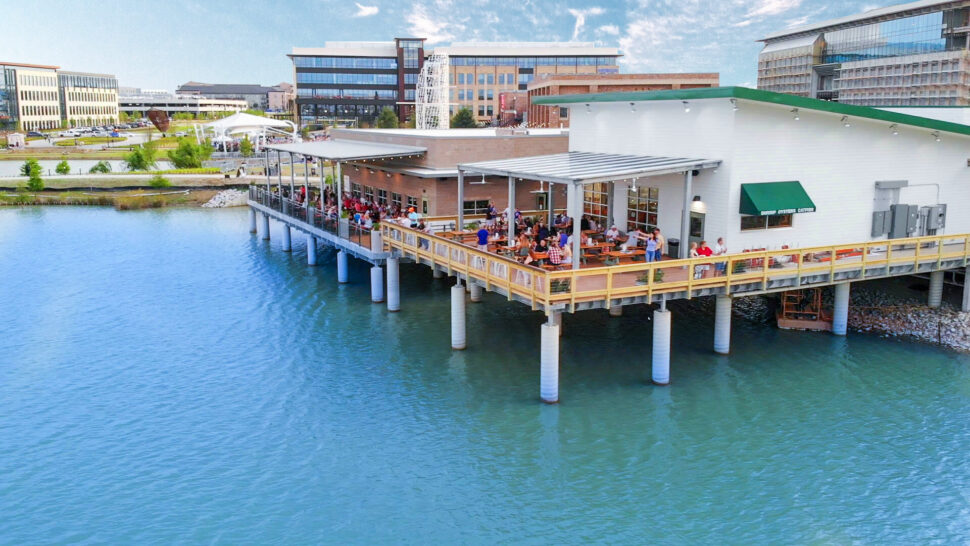
The Sound at Cypress Waters
The Sound hosts events most days, from “Wine Down Wednesdays” and Trivia Nights to concerts and holiday celebrations.
The development has become a destination development with restaurants and retail. Located on Interstate 635 at Belt Line Road minutes from Dallas Fort Worth International Airport, it’s slated to be on the DART Silver Line.
CityLine Builds a Park Place
At CityLine, ample greenspace is a focal point. The CityLine Plaza is a centrally located, one-acre urban plaza designed by the Office of James Burnett—the landscape architect of Dallas’ signature Klyde Warren Park. For an urban getaway, there are more than 20 acres in CityLine’s two city parks and plenty of hike and bike trails. One goes all the way to the University of Texas at Dallas campus, Alost says.
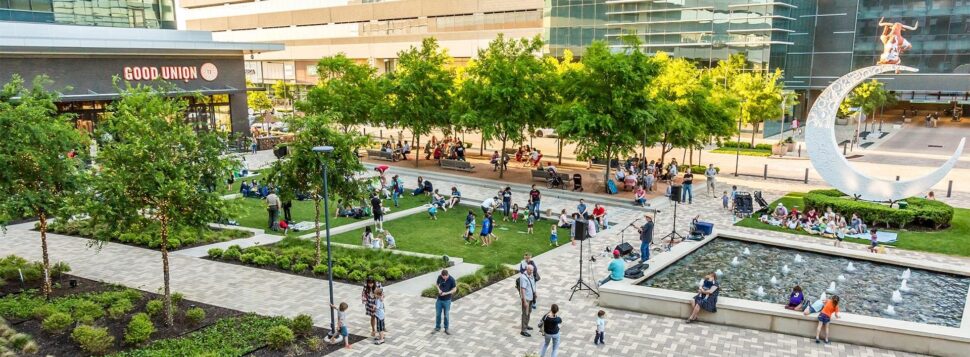
CityLine
The transit-oriented development, built for access, is located at the busy intersection of the President George Bush Turnpike and U.S. Highway 75. DART light rail runs right through it, currently with the Orange Line and Red Line.
The future Silver Line, estimated for completion in 2023, will go to DFW International Airport.
On the social side, Alost says that CityLine also programs a lot of activities, from a farmers’ market and concerts to yoga and tasting events.
“You need programs and activities because what you want to create is really a lifestyle,” he says.
“You think about what people want.”
Tall Towers & Hotel-Style Amenities
Country club and hotel amenities, like a nine-hole putting green, tennis courts, and pickleball courts, will appeal to both residents and employees, Billingsley says.
Cypress Waters is looking at “paradigms of hotels and country clubs, places that are great at creating amenities,” she says. “How do we do that as private developers?”
And while other developers might be struggling due to pandemic-related trends, Billingsley says she’s “thrilled and pleased” with the momentum at Cypress Waters.
A 300,000-square-foot multitenant building currently under construction will house biotech company Verily, a subsidiary of Alphabet. Drawn by the region’s growing stake in healthcare and technology, along with access to great talent, Verily execs plan to hire more than 100 employees for its first Texas office by the end of 2022.
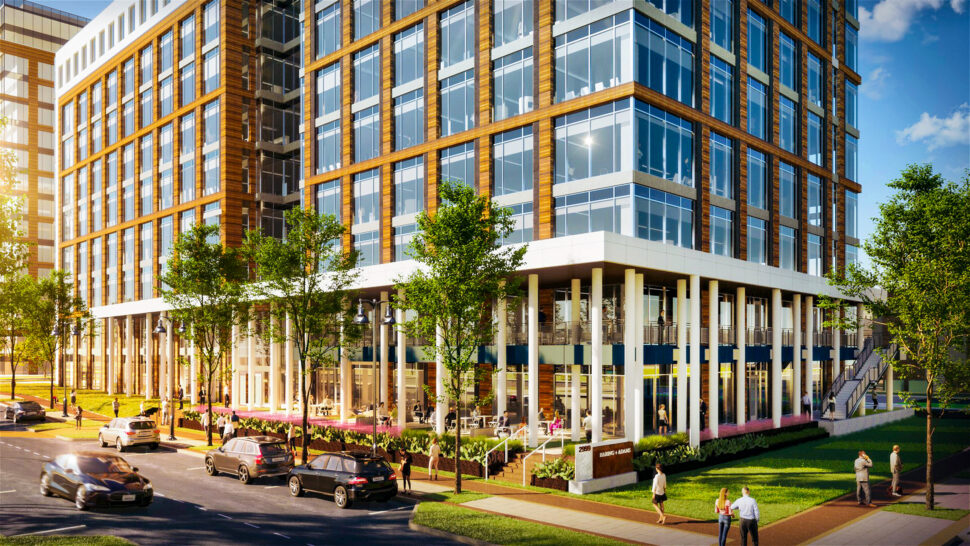
Verily ops hub at Cypress Waters
In Q1 of 2022, Billingsley expects construction to start on another 300,000-square-foot office building. The year should also bring the start of a 185,000-square-foot build-to-suit and three more office buildings at 250,000 square feet per building. For those of you keeping score at home, that’s more than 1.5 million square feet of office space slated for completion in the next few years, bringing the Cypress Waters total to more than 4.5 million square feet in offices.
Some 600 multifamily units are also under construction, likely to open in 2023. As of 2022, more than 5,000 residents call Cypress Waters home. Billingsley projects 8 to 9 million square feet of office space and 10,000 multifamily units at build-out. Daytime office population should be around 50,000 and evenings around 20,000.
CityLine’s Trio of Towers Build on Success
CityLine is about to reshape the skyline in Richardson with a new trio of towers. In September, KDC officials announced plans for three build-to-suit glass towers that will add nearly 1.4 million square feet at CityLine. The Dallas developer, which has been working on the $2 billion “city within a city” since 2013, says the towers build on the project’s success.
The towers, designed by Dallas-based Corgan, range in size from 13 stories and 356,000 square feet to 18 stories and 513,000 square feet.
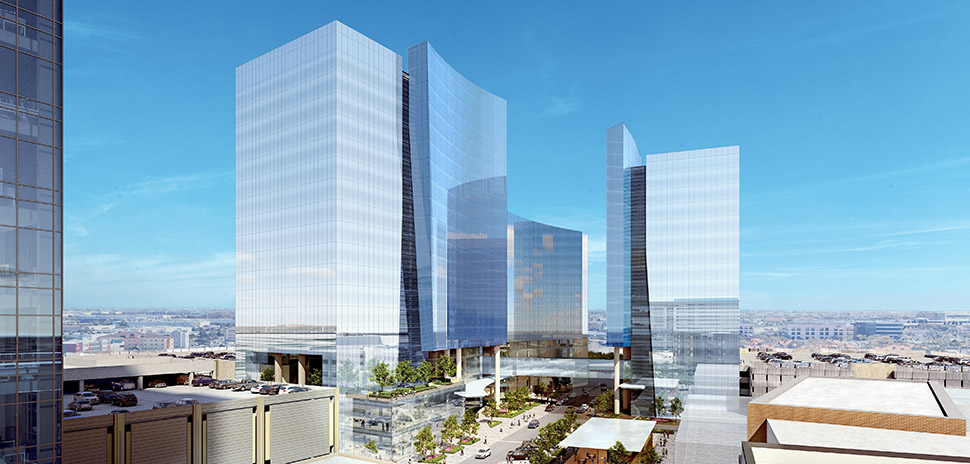
CityLine plans a new trio of tower that will reshape the Richardson skyline. [Image: Corgan and Associates]
“The concept is very flexible with the towers at different heights,” Alost says. “They have tremendous protected views that won’t be blocked by future development.” All three feature fifth-floor amenity levels, which can be linked together by skyways or kept separate, he says.
The towers’ interiors will incorporate tech for occupant health and well-being, as well as state-of-the-art fresh air filtration systems and touchless fixtures.
An indoor-outdoor experience is also by design, with ground level lobbies that face CityLine’s signature streetscapes with wide walkaways and sidewalk amenitites.
KDC also plans some mid-rise offices for a patch of ground south of Raytheon, while continuing to infill with more retail, multifamily, healthcare, and personal services.
“I think the best philosophy about development is to have a balanced environment that can satisfy what people want day or night,” Alost says.
Multifamily “Beat All Expectations” at Frisco Station
At Frisco Station, one of the biggest surprises has been the success of their multifamily offerings, Folzenlogen says.
“We continue to see growing demand for high-quality urban living,” he says. “It beats all expectations and speaks to the job growth we’re seeing.”
According to Folzenlogen, two things are vital: “You have to have patience and the capital to invest in these long-term projects.”
Frisco Station now has about 900 multifamily units, with more than 2,400 planned at build-out. They also have a corporate headquarters opportunity of one million square feet on 54 acres on the north end of the property and a group of build-to-suit towers along the tollway that would add another 3 million square feet.
With the pandemic hitting the retail industry hard, Frisco Station’s center of dining, shopping, and entertainment—The Hub—has been slow to develop. Folzenlogen says it’s just a matter of waiting for the right opportunities.
According to Folzenlogen, two things are vital: “You have to have patience and the capital to invest in these long-term projects.”
Enjoy Success, But Focus on the Long Game
The developers of the three developments are enjoying their current success. But they all continue to focus on the long game to keep moving forward. The developments all aim for success in terms of decades, and an evolutionary vision is behind their strategies.
CityLine’s Alost and his team “spend a lot of time facilitating the growth of various components so we can sustain quality growth.”
And Billingsley has one overall goal for the future of Cypress Waters: “I’m more and more committed to making this place remarkable.”
A version of this story first appeared in the print edition of DALLAS® Commercial Real Estate 2022. Read more in the digital edition of the magazine below, and request the next print edition here.
Get on the List
Request the next print edition of DALLAS® Commercial Real Estate here—and sign up for the Dallas Innovates e-newsletter for what’s new and next in North Texas business and CRE. To share your news or get information about the magazine, reach us here.
The real estate magazine is part of the DALLAS® media platform that includes the DALLAS® Relocation and Newcomer Guide and the DALLAS® Economic Development Guide. Published by Dallas Next for the Dallas Regional Chamber, together they tell the world about the future of live, work, learn, and play in North Texas.
![]()
Get on the list.
Dallas Innovates, every day.
Sign up to keep your eye on what’s new and next in Dallas-Fort Worth, every day.










